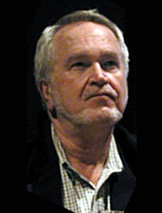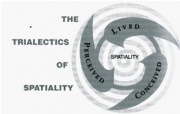Edward Soja
From Geography
| (5 intermediate revisions not shown) | |||
| Line 1: | Line 1: | ||
| - | |||
== Biography == | == Biography == | ||
| + | [[File:Edward Soja.jpg|200px|right|thumb| Professor of Urban Planning, Edward Soja. Source: http://www.spa.ucla.edu/main2.cfm?d=xr&f=news.cfm&s=school&news_id=19710]] | ||
| - | + | Edward William Soja (born in Bronx, New York in 1940) is a post-modern political geographer and planner, currently working as Distinguished professor of Urban Planning at the faculty of the University of Los Angeles (UCLA). He studied Geography at the Syracuse University in New York, which he succesfully completed and therefore received a Philisophers degree (Ph.D.). | |
| - | Edward William Soja ( | + | |
In his earlier work Soja mainly focussed on Africa, and especially on planning in Kenya, but for the past twenty years “Soja has focused his research and writing on urban restructuring in Los Angeles and more broadly on the critical study of cities and regions”, bringing together traditional political economy approaches and more recent developments in critical cultural studies (UCLA, department of Urban Planning, n.d.). “Of particular interest to him [Soja] is the way issues of class, race, gender, and sexuality intersect with what he calls the spatiality of social life, and with the new cultural politics of difference and identity that this generates” (UCLA, department of Urban Planning, n.d.). | In his earlier work Soja mainly focussed on Africa, and especially on planning in Kenya, but for the past twenty years “Soja has focused his research and writing on urban restructuring in Los Angeles and more broadly on the critical study of cities and regions”, bringing together traditional political economy approaches and more recent developments in critical cultural studies (UCLA, department of Urban Planning, n.d.). “Of particular interest to him [Soja] is the way issues of class, race, gender, and sexuality intersect with what he calls the spatiality of social life, and with the new cultural politics of difference and identity that this generates” (UCLA, department of Urban Planning, n.d.). | ||
| Line 12: | Line 11: | ||
== L'Autre == | == L'Autre == | ||
| + | Related to this, his main contribution to the fields of spatial theory and cultural geography consists out of his interpretation and ‘updating’ of the analytical spatial triad on the production of space (space is not something pre-given, an empty container, but is, instead, always a construction), as developed by the French sociologist [[Henri Lefebvre]] (consisting out of ‘[[perceived space]]’, ‘[[conceived space]]’ and ‘[[lived space]]’). | ||
| - | + | His ‘[[trialectics]] of spatiality’ (three approaches of spatiality) consists out of: | |
| + | |||
| + | * spatial practices ([[Firstspace]]), | ||
| + | |||
| + | * representations of space ([[Secondspace]]) | ||
| + | |||
| + | * and spaces of representation ([[Thirdspace]], the space of ‘othering’) (Soja, 1996). | ||
| + | |||
| + | These three ‘realms of space (Gregory, Johnston, Pratt, Watts & Whatmore 2009), respectively, coincide with the notions of perceived, conceived and lived space, as developed by Lefebvre. | ||
[[File:Trialectic-spatial.jpg |right|thumb| Figure 1: The Trialectics of Spatiality. Source: Soja E.W. (1996), Thirdspace: ''Journeys to Los Angeles and other real- and-imagened places'',pp. 72]] | [[File:Trialectic-spatial.jpg |right|thumb| Figure 1: The Trialectics of Spatiality. Source: Soja E.W. (1996), Thirdspace: ''Journeys to Los Angeles and other real- and-imagened places'',pp. 72]] | ||
| - | Edward Soja argues that the ‘[[lived space]]’ contains both [[Firstspace]] and [[Secondspace]] and adds 'something else' to it, so the [[Thirdspace]] is not a compromise between the [[Firstspace]] and the [[Secondspace]], as [[lived space]] is between [[perceived space]] and [[conceived space]]. [[Thirdspace]] offers an alternative that incorporates and differs the [[Firstspace]] and [[Secondspace]]. Which means there are no distinct, but blurred lines between the three elements (see Figure 1). In other words: The [[Thirdspace]] should be seen as an overall perspective to space, but remains free to fill in differently by everyone. This leads to a situation in which the 'best' or the 'real' space | + | Edward Soja argues that the ‘[[lived space]]’ contains both [[Firstspace]] and [[Secondspace]] and adds 'something else' to it, so the [[Thirdspace]] is not a compromise between the [[Firstspace]] and the [[Secondspace]], as [[lived space]] is between [[perceived space]] and [[conceived space]]. [[Thirdspace]] offers an alternative that incorporates and differs the [[Firstspace]] and [[Secondspace]]. Which means there are no distinct, but blurred lines between the three elements (see Figure 1). |
| + | In other words: The [[Thirdspace]] should be seen as an overall perspective to space (or a source of inspiration, an advice, a project) but remains free to fill in differently by everyone. This leads to a situation in which the 'best' or the 'real' space doesn't exist. | ||
This triad of spatiality is one of the two basic ‘[[trialectics]]’, as he labelled them, that where developed by Soja, on the basis of Lefebvre. Whereas the triad of spatiality is concerned with [[epistemology]], the other one is about [[ontology]]; ‘the trialecties of being’, consisting out of ‘historicality’, 'sociality', and 'spatiality' (Gregory et al., 2009). Special attention is given to the (third) notion of space, which is an essential concept for Soja, arguing that it “is characteristically erased in conventional social theory” (Gregory et al., 2009, p. 776). | This triad of spatiality is one of the two basic ‘[[trialectics]]’, as he labelled them, that where developed by Soja, on the basis of Lefebvre. Whereas the triad of spatiality is concerned with [[epistemology]], the other one is about [[ontology]]; ‘the trialecties of being’, consisting out of ‘historicality’, 'sociality', and 'spatiality' (Gregory et al., 2009). Special attention is given to the (third) notion of space, which is an essential concept for Soja, arguing that it “is characteristically erased in conventional social theory” (Gregory et al., 2009, p. 776). | ||
| - | By developing these trialectics, Soja’s main goal was to make clear the importance of the ‘other’ (L'autre), ‘third term’ in order ‘to defend against any binary reductionism or totalization’ (dialectics) (Gregory et al., 2009). | + | By developing these trialectics, Soja’s main goal was to make clear the importance of the ‘other’ ('''L'autre'''), ‘third term’ in order ‘to defend against any binary reductionism or totalization’ (dialectics) (Gregory et al., 2009). |
| + | |||
== References == | == References == | ||
| + | * Gregory, D., Johnston, R., Pratt, G., Watts, M. & Whatmore, S. (2009). ''The Dictionary of Human Geography'', 5th edition. London: Wiley-Blackwell Publishing. | ||
| - | + | * Soja, E.W. (1996) The extraordinary voyages of Henri Lefebvre, pp. 26-52; The trialectics of spatiality. In: ''Thirdspace: Journeys to Los Angeles and other real-and-imagined places''. Blackwell, Oxford, pp. 53-82. | |
| - | + | * UCLA department of Planning (n.d.). ''Edward Soja''. Accessed 13 October 2010, on http://www.spa.ucla.edu/dept.cfm?d=up&s=faculty&f=faculty1.cfm&id=251 | |
| - | |||
== Contributors == | == Contributors == | ||
| - | --[[User:MichaelVoorbraak|MichaelVoorbraak]] 12:17, 19 October 2011 (CEST) | + | |
| + | * ''General overview, Trialectics of spatiality and minor changes --[[User:MichaelVoorbraak|MichaelVoorbraak]]- 12:17, 19 October 2011 (CEST)'' | ||
| + | |||
| + | * ''Page added to the category [[Post-structuralism]] by Anke Janssen - ...'' | ||
| + | |||
| + | |||
| + | [[Category: Post-structuralism]] [[Category: Key Thinkers]] | ||
Latest revision as of 22:08, 25 October 2012
Contents |
Biography

Edward William Soja (born in Bronx, New York in 1940) is a post-modern political geographer and planner, currently working as Distinguished professor of Urban Planning at the faculty of the University of Los Angeles (UCLA). He studied Geography at the Syracuse University in New York, which he succesfully completed and therefore received a Philisophers degree (Ph.D.).
In his earlier work Soja mainly focussed on Africa, and especially on planning in Kenya, but for the past twenty years “Soja has focused his research and writing on urban restructuring in Los Angeles and more broadly on the critical study of cities and regions”, bringing together traditional political economy approaches and more recent developments in critical cultural studies (UCLA, department of Urban Planning, n.d.). “Of particular interest to him [Soja] is the way issues of class, race, gender, and sexuality intersect with what he calls the spatiality of social life, and with the new cultural politics of difference and identity that this generates” (UCLA, department of Urban Planning, n.d.).
Besides his focus on urban restructuring in Los Angeles , Soja also writes about the way “social scientists and philosophers think about space and geography, especially in relation to how they think about time and history” (UCLA, department of Urban Planning, n.d.).
L'Autre
Related to this, his main contribution to the fields of spatial theory and cultural geography consists out of his interpretation and ‘updating’ of the analytical spatial triad on the production of space (space is not something pre-given, an empty container, but is, instead, always a construction), as developed by the French sociologist Henri Lefebvre (consisting out of ‘perceived space’, ‘conceived space’ and ‘lived space’).
His ‘trialectics of spatiality’ (three approaches of spatiality) consists out of:
- spatial practices (Firstspace),
- representations of space (Secondspace)
- and spaces of representation (Thirdspace, the space of ‘othering’) (Soja, 1996).
These three ‘realms of space (Gregory, Johnston, Pratt, Watts & Whatmore 2009), respectively, coincide with the notions of perceived, conceived and lived space, as developed by Lefebvre.
Edward Soja argues that the ‘lived space’ contains both Firstspace and Secondspace and adds 'something else' to it, so the Thirdspace is not a compromise between the Firstspace and the Secondspace, as lived space is between perceived space and conceived space. Thirdspace offers an alternative that incorporates and differs the Firstspace and Secondspace. Which means there are no distinct, but blurred lines between the three elements (see Figure 1). In other words: The Thirdspace should be seen as an overall perspective to space (or a source of inspiration, an advice, a project) but remains free to fill in differently by everyone. This leads to a situation in which the 'best' or the 'real' space doesn't exist.
This triad of spatiality is one of the two basic ‘trialectics’, as he labelled them, that where developed by Soja, on the basis of Lefebvre. Whereas the triad of spatiality is concerned with epistemology, the other one is about ontology; ‘the trialecties of being’, consisting out of ‘historicality’, 'sociality', and 'spatiality' (Gregory et al., 2009). Special attention is given to the (third) notion of space, which is an essential concept for Soja, arguing that it “is characteristically erased in conventional social theory” (Gregory et al., 2009, p. 776).
By developing these trialectics, Soja’s main goal was to make clear the importance of the ‘other’ (L'autre), ‘third term’ in order ‘to defend against any binary reductionism or totalization’ (dialectics) (Gregory et al., 2009).
References
- Gregory, D., Johnston, R., Pratt, G., Watts, M. & Whatmore, S. (2009). The Dictionary of Human Geography, 5th edition. London: Wiley-Blackwell Publishing.
- Soja, E.W. (1996) The extraordinary voyages of Henri Lefebvre, pp. 26-52; The trialectics of spatiality. In: Thirdspace: Journeys to Los Angeles and other real-and-imagined places. Blackwell, Oxford, pp. 53-82.
- UCLA department of Planning (n.d.). Edward Soja. Accessed 13 October 2010, on http://www.spa.ucla.edu/dept.cfm?d=up&s=faculty&f=faculty1.cfm&id=251
Contributors
- General overview, Trialectics of spatiality and minor changes --MichaelVoorbraak- 12:17, 19 October 2011 (CEST)
- Page added to the category Post-structuralism by Anke Janssen - ...
